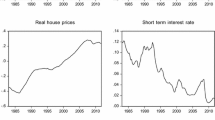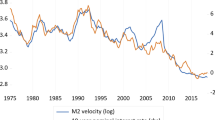Abstract
Recent empirical studies have found evidence of unstable long run money demand functions if recent data are used. If the link between money balances and the macroeconomy is fragile, the rationale of monetary aggregates in the ECB strategy has to be doubted. In contrast we present a “stable” long run money demand relationship for M3 for the period 1983–2006. To obtain the result, the short run homogeneity restriction between money and prices is relaxed and a break in the income elasticity of money demand after 2001 is taken into account. Measures of excess liquidity do not show significant inflation pressures.
Similar content being viewed by others
References
Artis, M., & Beyer, A. (2004). Issues in money demand. The case of Europe. Journal of Common Market Studies, 42, 717–736.
Boone, L., & Van den Noord, P. (2008). Wealth effects on money demand in the euro area. Empirical Economics, 34, 525–536.
Bosker, E. M. (2006). On the aggregation of eurozone data. Economics Letters, 90, 260–265.
Brand, C., & Cassola, N. (2004). A money demand system for euro area M3. Applied Economics, 8, 817–838.
Brüggemann, R., & Lütkepohl, H. (2005). Practical problems with reduced rank ML estimators for cointegration parameters and a simple alternative. Oxford Bulletin of Economics and Statistics, 67, 673–690.
Brüggemann, R., & Lütkepohl, H. (2006). A small monetary system for the euro area based on German data. Journal of Applied Econometrics, 21, 683–702.
Bruggemann, A., Donati, P., & Warne, A. (2003). Is the demand for euro area M3 stable? In O. Issing (Ed.), Background studies for the ECB’s evaluation of monetary policy strategy (pp. 245–300). ECB: Frankfurt.
Carstensen, K. (2006). Stock market downswing and the stability of European Monetary Union money demand. Journal of Business and Economic Statistics, 24, 395–402.
Coenen, G., & Vega, J.-L. (2001). The demand for M3 in the euro area. Journal of Applied Econometrics, 16, 727–748.
Dreger, C., & Wolters, J. (2010). Investigating M3 money demand in the euro area. Journal of International Money and Finance, 29, 111–122.
Ericsson, N. R. (1998). Empirical modelling of money demand. Empirical Economics, 23, 295–315. Reprinted in: H. Lütkepohl & J. Wolters (Eds.), Money demand in Europe (pp. 29–49). Heidelberg: Physica, 1999.
European Central Bank (2001). Monthly Bulletin, May: 41–58.
European Central Bank (2004a). The monetary policy of the ECB. ECB 2nd ed.
European Central Bank (2004b). Monetary analysis in real time, Monthly Bulletin, October: 43–66.
Fagan, G., & Henry, J. (1998). Long run money demand in the EU: evidence for area-wide aggregates. Empirical Economics, 23, 483–506. Reprinted in H. Lütkepohl & J. Wolters (Eds.), Money demand in Europe (pp. 217–240). Heidelberg: Physica, 1999.
Funke, M. (2001). Money demand in Euroland. Journal of International Money and Finance, 20, 701–713.
Gerlach, S. (2004). The two pillars of the European Central Bank. Economic Policy, 19, 389–439.
Gerlach, S., & Svensson, L. O. E. (2003). Money and inflation in the euro area: a case for monetary indicators? Journal of Monetary Economics, 50, 1649–1672.
Golinelli, R., & Pastorello, S. (2002). Modelling the demand for M3 in the euro area. European Journal of Finance, 8, 371–401.
Greiber, C., & Lemke, W. (2005). Money demand and macroeconomic uncertainty. Deutsche Bundesbank Discussion Paper 26/05, Frankfurt: Deutsche Bundesbank.
Greiber, C., & Setzer, R. (2007). Money and housing: Evidence for the euro area and the US. Deutsche Bundesbank, Research Center, Discussion Paper Series 1, Economic Studies 2007-12.
Hallman, J. J., Porter, R. D., & Small, D. H. (1991). Is the price level tied to the M2 monetary aggregate in the long run? American Economic Review, 81, 841–858.
Hayo, B. (1999). Estimating a European demand for money. Scottish Journal of Political Economy, 46, 221–244.
Holtemöller, O. (2004a). Aggregation of national data and stability of euro area money demand. In C. Dreger & G. Hansen (Eds.), Advances in macroeconometric modelling. Papers and proceedings of the 3rd IWH workshop in macroeconometrics (pp. 181–203). Baden-Baden: Nomos.
Holtemöller, O. (2004b). A monetary vector error correction model of the euro area and implications for monetary policy. Empirical Economics, 29, 553–574.
Hwang, H.-S. (1985). Test of the adjustment process and linear homogeneity in a stock adjustment model of money demand. Review of Economics and Statistics, 67, 689–692.
Johansen, S. (1995). Likelihood based inference in cointegrated vector autoregressive models. Oxford: Oxford University Press.
Kirchgässner, G., & Savioz, M. (2001). Monetary policy and forecasts for real GDP growth: An empirical investigation for the Federal Republic of Germany. German Economic Review, 4, 339–365.
Kirchgässner, G., & Wolters, J. (2007). Introduction to modern time series analysis. Berlin: Springer.
Kirchgässner, G., & Wolters, J. (2010, to appear). The role of monetary aggregates in the policy analysis of the Swiss National Bank. Swiss Journal of Economics and Statistics.
Kontolemis, Z. G. (2002). Money demand in the euro area. Where do we stand? IMF Working Paper WP 02/185.
Lütkepohl, H., Teräsvirta, T., & Wolters, J. (1999). Investigating stability and linearity of a German M1 money demand function. Journal of Applied Econometrics, 14, 511–525.
MacKinnon, G., Haug, A., & Michelis, L. (1999). Numerical distribution functions of likelihood ratio tests for cointegration. Journal of Applied Econometrics, 14, 563–577.
Masuch, K., Pill, H., & Willeke, C. (2001). Framework and tools of monetary analysis. In H. J. Klöckers & C. Willeke (Eds.), Monetary analysis. Tools and applications (pp. 117–144). Frankfurt: European Central Bank.
Neumann, M. J. M., & Greiber, K. (2004). Inflation and core money growth in the euro area. Deutsche Bundesbank Discussion Paper 36/04, Frankfurt: Deutsche Bundesbank.
Reimers, H.-E. (1992). Comparisons of tests for multivariate cointegration. Statistical Papers, 33, 335–359.
von Hagen, J. (2004). Hat die Geldmenge ausgedient? Perspektiven der Wirtschaftspolitik, 5, 423–453.
Wolters, J., & Lütkepohl, H. (1997). Die Geldnachfrage für M3: Neue Ergebnisse für das vereinigte Deutschland. ifo Studien, 43, 35–54.
Wolters, J., Teräsvirta, T., & Lütkepohl, H. (1998). Modeling the demand for M3 in the unified Germany. Review of Economics and Statistics, 80, 399–409.
Author information
Authors and Affiliations
Corresponding author
Rights and permissions
About this article
Cite this article
Dreger, C., Wolters, J. M3 money demand and excess liquidity in the euro area. Public Choice 144, 459–472 (2010). https://doi.org/10.1007/s11127-010-9679-5
Received:
Accepted:
Published:
Issue Date:
DOI: https://doi.org/10.1007/s11127-010-9679-5




